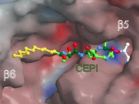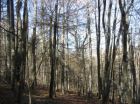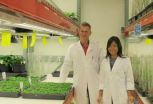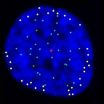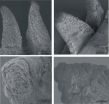(Press-News.org) This press release is available in German.
In their quest for new agents, pharmaceutical researchers test millions of substances all over the world. They like using color-forming reactions to identify new molecules. However, in intensively colored solutions or in the case of mixtures with multiple substances these tests fail. As part of his doctoral thesis, Martin Stein, member of staff at the Chair of Biochemistry at the Technische Universitaet Muenchen, developed a testing reaction based on magnetic resonance data. It helps find a specific pharmaceutical molecule among hundreds of different substances even in the most turbid of bacterial brews.
As a test reaction, the research team used the decomposition of a short amino acid chain caused by the proteasome. Similar to a recycling facility this vitally important cell protein breaks down superfluous proteins into small pieces. To follow the reaction, they integrated a special carbon atom into the chain: it has one neuron more than normal carbon and its magnetic resonance signal is sensitive to a scission of the chain. Under normal circumstances, the proteasome will decompose the amino acid chain, effecting a change in the signal from the carbon-13 atom. If it does not react, the solution must contain a substance that inhibits the work of the proteasome.
Cancer cells suffocating in garbage
The pharmaceutical industry is always on the lookout for precisely such substances to deploy them against threads like cancer. In the case of cancer, for example, when the proteasome is blocked, rapidly growing cancer cells choke on their own waste. The first medication of this kind is already generating annual revenues of over one billion US dollars. The scientists are now looking for further substances with lesser side effects.
Following preliminary studies, one such candidate was a toxic substance produced by the bacterium Photorhabdus luminescens. This is the poison that kills the larvae of the garden chafer. Using his new methodology, the scientists discovered that the bacterium lives inactively in the intestines of the threadworm. When it lays its eggs, the worm infects the larvae. The sudden change in environment causes the bacterium to emit toxins. After the larva dies, the bacterium ceases to produce toxins. Once the threadworms hatch from the protective egg membrane, they ingest the inactive bacterium into their intestines, and the cycle can start again.
Since the newly developed method also works in intensively colored solutions and in the presence of hundreds of other substances, the workgroup at the Chair of Biochemistry succeeded in isolating the unknown poison directly from the bacterial brew: It turned out to be two structurally very similar compounds, cepafungin I and glidobactin A. The latter was previously considered the strongest proteasome blocker. In spite of the resemblance, cepafungin I had never been tested as a proteasome blocking agent. The tests of the research group showed that Cepafungin I is indeed a strong Proteasomhemmer. In effect, it even surpasses the previous record holder.
Production by bacteria
The production of elaborate pharmaceutical substances via bacteria is the silver bullet in pharmaceutical production. However, there is one catch: Just like with the bacterium Photorhabdus luminescens, the sought-after natural substances are produced in significant amounts during only one phase of the bacterial life cycle. But here, too, the new method has a decisive advantage: "A measurement cycle takes approximately 15 minutes, which means almost 100 samples can be analyzed per day," says Martin Stein. "This allows us to determine very quickly the circumstances under which the bacterium will yield an optimal amount of the active agent".
The bacterium Pseudomonas syringae also counts on the deadly effect of its proteasome inhibitor. When the bacterium attacks a bean plant, its leaves turn brown and die. This is caused by the substance syringolin A, which has a basic structure very similar to that of cepafungin I and glidobactin A. It inhibits the proteasome of the plant cell and thus blocks the plant's defense against the brown spot disease.
"We gained an important insight from these tests," says Prof. Michael Groll, head of the research team. "Nature has already optimized the basic structure of these substances to inhibit the proteasome. It works in plants as well as in insects and even in people. If we center our research into new agents on these natural substances, we could save valuable time in medication development."
INFORMATION:
The work was funded by the Cluster of Excellence Center for Integrated Protein Science Munich (CIPSM). The crystal structures of proteasome complexes were determined using the Swiss Light Source at the Paul Scherrer Institute (Villigen, Switzerland).
Original publication:
One-shot NMR analysis of microbial secretions identifies highly potent proteasome inhibitor; Martin L. Stein, Philipp Beck, Markus Kaiser, Robert Dudler, Christian F. W. Becker and Michael Groll, PNAS, Vol. 109, 45, 18367-71
DOI: 10.1073/pnas.1211423109 – http://www.pnas.org/content/109/45/18367
Poison for cancer cells
A new method identifies active agents in mixtures of hundreds of substances
2012-12-20
ELSE PRESS RELEASES FROM THIS DATE:
Clean air: New paints break down nitrogen oxides
2012-12-20
The Seventies: Smog alert in the Ruhr area, acid rain, dying spruce trees in the Bavarian Forest. In those days, the solution was filter systems for the smokestacks in the Ruhr area. Today, people in the urban areas are suffering from high levels of pollution that is being caused by, among other things, automotive traffic. Particularly undesired: the nitrogen oxides (NOX). In the meantime, the European Union tightened the limit values even further; in many communities they are being exceeded. Michael Hüben of the Fraunhofer Institute for Molecular Biology and Applied Ecology ...
Aldrich Materials Science discovers liquid-free preparation of metal organic frameworks
2012-12-20
St. Louis, MO – December 18, 2012 – Researchers at Aldrich Materials Science, a strategic technology initiative of Sigma-Aldrich Corporation (NASDAQ:SIAL) have discovered an innovative way to design an important class of three-dimensional (3D) hybrid structures, Metal Organic Frameworks (MOFs), under completely liquid-free conditions. High purity MOF products prepared by the liquid-free process may be ideally suited as rare earth containing materials for sensors and detectors, electronic or magnetic materials. The discovery also extends liquid-free preparation techniques ...
Pair of proteins gets brain cells into shape
2012-12-20
This press release is available in German.
The study conducted by Prof. Frank Bradke's team provides indications on brain development and about the causes of diseases of the nervous system. The results have now been published in "Neuron".
Under the microscope, the brain appears as a network of intricate beauty comprising billions of nerve cells (the so-called "neurons") linked together. This network is engaged in a constant process of sharing information. The signals are transmitted from neuron to neuron through fine ramifications of the cell body. However, to acquire ...
University of Alberta research working towards treatment for aortic aneurysms in the abdomen
2012-12-20
A researcher with the Faculty of Medicine & Dentistry and the Mazankowski Alberta Heart Institute is looking closely at a molecule linked to aortic aneurysms in the abdomen, and her findings could lead to a treatment to reduce swelling of the aortic artery, which would be a life-saving treatment.
Zamaneh Kassiri, a professor in the Department of Physiology, and Ratnadeep Basu, a PhD trainee in Kassiri's lab, have been looking at the role of a protein called TIMP3 in the vessels. Their most recent findings, published in The Journal of Biological Chemistry, shows that animal ...
Death of hemlock trees yields new life for hardwood trees, but at what cost to the ecosystem?
2012-12-20
URBANA – Due to the introduction of exotic pests and pathogens, tree species are being eliminated one by one from forest ecosystems. In some cases, scientists can observe immediately how their loss affects the environment, whereas in other cases, creative puzzle solving and analysis reveal unexpected repercussions. In the case of the loss of the hemlock tree, University of Illinois landscape and ecosystem ecologist Jennifer Fraterrigo uncovered a surprising benefit to hardwood species.
Throughout much of the eastern United States, a pest called the hemlock woolly adelgid ...
Discovery may pave way to genetically enhanced biofuel crops
2012-12-20
Best known for its ability to transform simmering pots of sugared fruit into marmalades and jams, pectin is a major constituent of plant cell walls and the middle lamella, the sticky layer that glues neighboring plant cells together. Pectin imparts strength and elasticity to the plant and forms a protective barrier against the environment. Several different kinds of pectic compounds combine to form pectin. The relative proportion of each of these depends on the plant species, location within the plant, and environment. Pectic compounds decorated with β-1,4-galactan ...
Chromosome 'anchors' organize DNA during cell division
2012-12-20
LA JOLLA, CA----For humans to grow and to replace and heal damaged tissues, the body's cells must continually reproduce, a process known as "cell division," by which one cell becomes two, two become four, and so on. A key question of biomedical research is how chromosomes, which are duplicated during cell division so that each daughter cell receives an exact copy of a person's genome, are arranged during this process.
Now, scientists at the Salk Institute have discovered a new characteristic of human cell division that may help explain how our DNA is organized in the ...
From farm to table, mealworms may be the next best food
2012-12-20
Food enthusiasts interested in sustainable farm practices may soon have a new meat alternative: insects. Beetle larvae (called mealworms) farms produce more edible protein than traditional farms for chicken, pork, beef or milk, for the same amount of land used, according to research published December 19 in the open-access journal PLOS ONE by Dennis Oonincx and colleagues from the University of Wageningen, Netherlands.
The researchers compared the environmental impact of meat production on a mealworm farm to traditional animal farms using three parameters: Land usage, ...
Human history preserved in tree rings of prehistoric wooden wells
2012-12-20
Prehistoric farming communities in Europe constructed water wells out of oak timbers, revealing that these first farmers were skilled carpenters long before metal was discovered or used for tools. The research published December 19 in the open access journal PLOS ONE by Willy Tegel and colleagues from the University of Freiburg, Germany, contradicts the common belief that metal tools were required to make complex wooden structures.
The wooden water wells discovered in eastern Germany are over 7000 years old, and suggest that these early farmers had unexpectedly refined ...
Lizard tails detach at a biological 'dotted line'
2012-12-20
Like sheets of paper marked with perforated lines, gecko tails have unique structural marks that help them sever their tails to make a quick getaway. Though voluntarily shedding a body part in this manner is a well-known phenomenon, research published December 19 in the open access journal PLOS ONE reveals aspects of the process that may have applications for structural engineers making similar, quickly detachable structures.
VIDEO:
Bridging structures are not present between ...
LAST 30 PRESS RELEASES:
Empress cicada wings help illuminate molecular structure
Using sound waves to detect helium
Time burden in patients with metastatic breast and ovarian cancer from clinic and home demands
Researchers discover bias in AI models that analyze pathology samples
Scientists ID potential way to prevent brain injuries from triggering Alzheimer's
MASTER 2nd Open Call: Execution period kick-off
Algae for health in food and pharma
Advanced microrobots driven by acoustic and magnetic fields for biomedical applications
Chicago health information leader recognized for raising CPR readiness and blood pressure awareness
The Intimate Animal, a new book from Kinsey Institute Executive Director Dr. Justin Garcia
When blue-collar workers lose union protection, they try self-employment
New video dataset to advance AI for health care
MEA-based graph deviation network for early autism syndrome signatures in human forebrain organoids
New modeling approach sheds light on rare gut disease
Study documents potentially hazardous flame retardants in firefighter gear
Can certain bacteria regulate aging of the immune system and its related alterations?
AI model helps diagnose often undetected heart disease from simple EKG
There are fewer online trolls than people think
Cell membrane fluctuations produce electricity
Jeonbuk National University study shows positive parenting can protect adolescents against self-harm
Surface-engineered ZnO nanocrystals to tackle perfluoroalkyl substance contamination
This new understanding of T cell receptors may improve cancer immunotherapies
A new fossil face sheds light on early migrations of ancient human ancestor
A new immunotherapy approach could work for many types of cancer
A new way to diagnose deadly lung infections and save lives
40 percent of MRI signals do not correspond to actual brain activity
How brain-inspired algorithms could drive down AI energy costs
Gum disease may be linked to plaque buildup in arteries, higher risk of major CVD events
Contrails are a major driver of aviation’s climate impact
Structure of dopamine-releasing neurons relates to the type of circuits they form for smell-processing
[Press-News.org] Poison for cancer cellsA new method identifies active agents in mixtures of hundreds of substances
